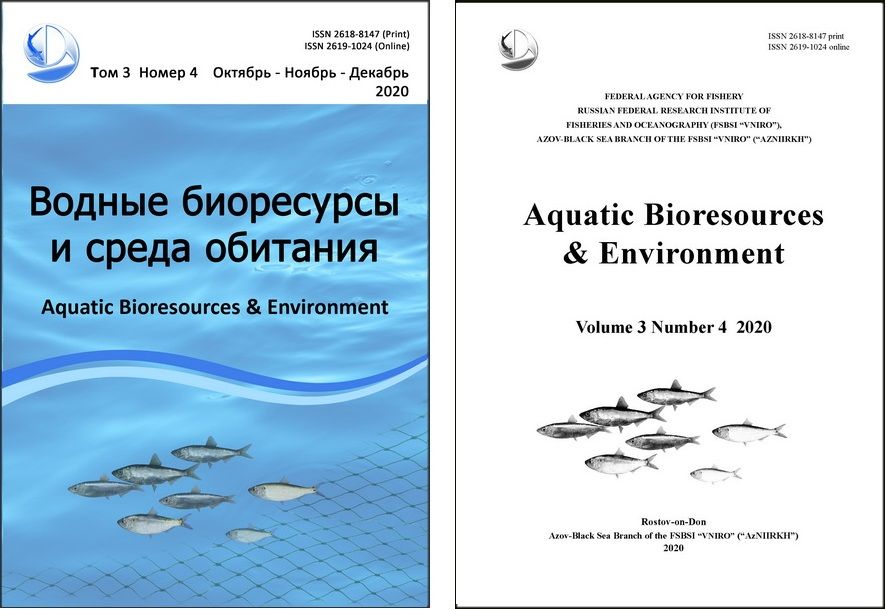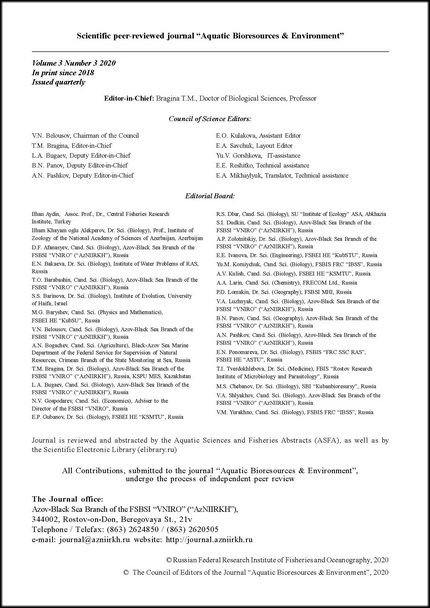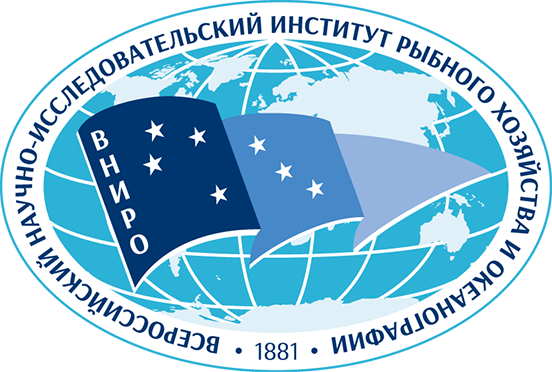

Environmental Concerns and the State of Aquatic Environment
Hydrological and hydrochemical criteria for typification of the water bodies aimed for development of commercial aquaculture in the southern and south-eastern parts of the Rostov Region
Barabashin T.O., Kosenko Yu.V., Zhukova S.V., Belousov V.N., Korablina I.V.
Abstract. This paper presents materials on the development of criteria for the typification of water bodies for the purposes of commercial aquaculture on the example of model water bodies in the Rostov Region. Altogether, 24 water bodies located in the southern and south-eastern parts of the Region have been investigated. The development of criteria for the typification of water bodies has been carried out based on hydrological and hydrochemical indicators, which were scored in 4 blocks. The total score established for the main hydrological and hydrochemical parameters can be used as a criterion for a water body being suitable for the purposes of commercial aquaculture. The dependence of suitability of the water body for fish farming on its location, the average annual flow rate of rivers or the annual precipitation–evaporation ratio according to the established scores has not been revealed. However, in the zone of very arid climate, more unusable water bodies have been identified. Since, according to the conditions of water availability, almost all water bodies should be classified as the reservoirs that are insecure for fish farming, the number of water bodies not recommended or recommended with significant restrictions amounted to only 25 % of the total. This indicates a fairly high potential for fish farming even in the arid zone of the Rostov Region. A brief hydrological and hydrochemical characterization of each investigated water body can be used to develop scientifically grounded recommendations for the organization of fish farms for the purposes of commercial aquaculture.
Keywords: hydrology, hydrochemistry, water bodies, typification, commercial aquaculture, Rostov Region
Hydrometeorological conditions of the Kerch Bay in 2017–2019
Kochergin A.T., Borovskaya R.V.
Abstract. Based on the data from weekly hydrometeorological observations, conducted in the Kerch Bay in 2017–2019, comparative analysis of variability in average monthly values of surface air and water temperatures, wind activity and wave action, water transparency, and salinity of the upper water layer with those recorded in 2007–2009 has been conducted; these two time ranges have been also compared with similar conditions of the second half of the 20th century and the beginning of the 21st century. During the recent decade, a trend of the increase in the amount of hot summer days and the decrease of freezing winter ones was recorded, as well as the raise of water salinity by a significant measure, from 10.7–12.8 to 14.5–17.6 ‰, resulting from the reduction of freshwater river flow into the Azov Sea and increased evaporation due to higher water temperature. Prevailing negative anomalies of wind speed were observed, as well as the change of the negative trend in the first time range to the positive trend in the second one. Due to the limited fetch distance, average monthly wave height in the bay over the course of entire 2017–2019 observations did not exceed 0.9 m. Correspondence between positive trends of wave height and wind speed was recorded. During the same period, the annual maximum of transparency coincided with the summer season, whereas the annual minimum fell on different months of the other seasons.
Keywords: Kerch Bay, wind activity, air temperature, water temperature, salinity, wave action, water transparency, anomalies
Current state of the habitat of commercial invertebrates in the hypersaline lakes of Crimea
Borovskaya R.V., Zhugaylo S.S., Pugach M.N., Adzhiumerov E.N., Krivoguz D.O.
Abstract. Hydrological and hydrochemical conditions in the hypersaline water bodies of Eupatorian, Tarkhankut, Perekopsk, and Kerch groups of lakes were investigated. Fisheries value of these lakes lies in providing the habitat for such fishing targets as brine shrimps (Artemia) and chironomids. As the main source of primary empirical data, findings of the expeditions conducted in the spring, summer and autumn seasons of 2017–2019 have been used. As a result, it has been found out that, in general, abiotic environmental factors in the majority of the lakes in the spring – autumn season were adequate for development of the aquatic living organisms inhabiting them. It was supported by positive hyrdobiological developmental indices of these species and indicated their high adaptability to the existing state of their habitat, in particular, saline and oxygen regimens. However, the autumn season of 2017 was unfavorable for most of the lakes in terms of development of the aquatic living organisms. Substantial increase in salinity led to the depression of brine shrimp populations and to the death of chironomids. A fairly high content of mercury in some hypersaline water bodies located in the Western and Northern Crimea also comes under notice. In the case of Aygul Lake, it is associated with proximity of chemical enterprises; however, the sources of polluting substances in the other investigated water bodies at present remain unknown and require further investigation.
Keywords: Crimea, hypersaline lakes, abiotic factors, brine shrimp, chironomids
Biology and Ecology of Aquatic Organisms
Phytoplankton-based biomonitoring in assessing the pollution level of a lentic freshwater body in Hooghly District, West Bengal, India
Pore S., Ghosh S., Keshri J.P., Barinova S.S.
Abstract. Phytoplankton is the base of every aquatic food web. During the assessment of the trophic status of the investigated lentic water body (within Lake City Housing Complex, Mankundu, Hooghly, West Bengal, India), phytoplankton composition and its temporal variation are proved to be the most important. In this study, 30 phytoplankton taxa have been recorded in various arrangements throughout the season. The maximum number of phytoplankton species with the highest Shannon–Weaver diversity index value represented the pre-monsoon season, whereas the least number of phytoplankton taxa and the lowest diversity indicators characterized the post-monsoon season. The development of algal bloom by one specific taxon, Botryococcus braunii, in the post- monsoon season indicates the change in the trophic status of this particular water body. As a criterion for the beginning of the algal bloom, an exceedance of 1 mg/L in nitrate concentration can be considered. The phytoplankton composition, values of various diversity indices, its density and species distribution pattern, and selected environmental parameters have been investigated, as well as the results of the analysis of rank abundance curves, which allowed for evaluation of the ecological status of this lentic water body. This study describes the change or shift in the ecosystem of the investigated water body towards eutrophication and establishes its pollution level as moderate to light.
Keywords: phytoplankton, diversity, biomonitoring, climatic seasons, West Bengal, India
Morphological features of oogenesis of the Pacific oyster(Crassostrea gigas, Thunberg) introduced into the Black Sea
Zolotnitskiy A.P.,
| Orlenko А.N. |
described by an exponential equation: No = 14,4 × e-0,082×T . The synchronicity of the changes in volumes of acini, oocytes and cell nuclei in the course of the reproductive cycle is shown, as well as the interrelationship between the volumes of these components. There was found to exist an asynchronicity in nuclei functioning and the
nucleoplasmic index in the process of reproduction, which is linked with the synthesis of ribosomal proteins. Following the obtained data, 1-to-6 score of the maturity stages for the Pacific oyster females in the course of annual reproductive cycle is presented: passive state; beginning of oogenesis; active oogenesis; pre-spawning state; maturation and spawning; post-spawning transformation. The months, during which each maturity stage was the most prevalent, are given.
Keywords: Crassostrea gigas, oogenesis, acinus, oocytes, nucleus, nucleolus, nucleoplasmic index, reproductive cycle, maturity stages
Fisheries and Processing of Aquatic Bioresources
Prospective uses of the macrophyte storm debris in the wrack zone of the Azov and Black Sea Fishery Basin (review)
Belyakova I.A., Chernyavskaya S.L., Esina L.M., Bogomolova V.V., Krivonos O.N.,
Abstract. Mass aggregations of brown algae Cystoseira and seagrass Zostera (eelgrass), which are formed along the wrack line during storms and natural exfoliation, can be considered one of the underexploited primary resources of the Azov and Black Sea Fishery Basin. As a rule, the process of their aggregation falls on the summer - autumn season, which coincides with the high season, leading to people's discomfort during their recreation time. Therefore, the issue of the prospective utilization of algae storm debris, its harvesting and primary processing can be deemed quite vital. The investigated macrophytes, washed ashore during storms or seasonally, are the source of valuable materials; Zostera provides zosterin and fiber, and Cystoseira is rich in alginic acid, iodine and selenium. This article considers proven methods of algae processing for nutritional purposes, obtaining dietary supplements and cosmetic products, in paper manufacturing, and the use of macrophytes as fertilizers and animal fodder. The methods of primary processing, entailing the best possible preservation of quality of the investigated algae and involving the processes of drying, freezing and chemical treatment, are studied. Specifics of algae storm debris collection and the necessity of timely removal of macrophytes from sandy coastline are indicated. Recommendations on natural and artificial drying, freezing and salting of macrophytes are given.
Keywords: eelgrass, seagrass, Zostera marina, Cystoseira barbata, storm debris, freezing, drying, salting, alginic acid, zosterin
Revision of standardization documents on air-dried fish to ensure their compliance with the requirements of TR EAEU 040/2016
Esina L.M., Gorbenko L.A.
Abstract. Fish products, obtained through curing, drying and dry-curing processes, are in great demand among the population and represent a ready-to-eat food item. This article presents a comparative analysis of the requirements of TR EAEU (Technical Regulation of the Eurasian Economic Union) 040/2016 and standardization documents to the moisture content in cured, dried, dry-cured and air-dried fish; inconsistency in these requirements, which should be eliminated during revision of the specifications for the indicated types of products, is identified. Results of the investigation of moisture content, conducted on samples of the cured and air-dried fish distributed through a market chain, are presented; they have shown that the major part of the investigated products did not meet the norms of moisture content, prescribed by the standards. For this reason, labeling of these products can be viewed as misleading in terms of complete and accurate information on a food item. Another requirement of TR EAEU 040/2016 to the cured and air-dried fish — presence of the characteristics of an ripened product — has also been analyzed. This article points out that the standardization documents do not provide biochemical indicators that could make it possible to evaluate the process of ripening in cured and air-dried fish; ripening characteristics are conveyed verbally along with the description of organoleptic properties. In terms of buffer value, investigation of the ripening level of cured and air-dried fish, distributed through a market chain, has shown it to be low for the products derived from lookdown, Black Sea horse mackerel, goby, Atlantic mackerel, and Atlantic herring, as compared to cured and air-dried Caspian roach. This article indicates that the presence of characteristics of ripened products cannot include all fish species used for production of cured and air-dried fish. Results of the conducted analysis have been used in development of the international standard for air-dried fish.
Keywords: cured fish, air-dried fish, ripening, standards, buffering, moisture content, organoleptic properties
Investigation of microbiological indicators of calcium feed additive derived from veined rapa whelk Rapana venosa shells
Chernyavskaya S.L., Esina L.M., Krivonos O.N., Bogomolova V.V., Belyakova I.A.
Abstract. The relevance of this research is conditioned by the absence of industrial utilization of the waste discarded while processing the veined rapa whelk (shells), despite the fact that this mullusc is caught in the Azov and Black Sea Fishery Basin annually. As a result of processing 2,746.1 tonnes of rapa whelk captured in the Azov Sea in 2019, almost 2,000 tonnes of shells were derived. The microbiological safety indicators of the calcium feed additive derived from veined rapa whelk have been investigated, which was necessitated by the parts of mollusc viscera remaining in 50 % of shell cones after their processing. Samples of the calcium feed additive were prepared in five ways, differing in temperature (20, 80, 105 °C) and duration of drying (12 and 24 hrs, 3 and 9 months), as well as the presence/absence of viscera remains. The total bacterial load in all samples did not exceed the established norms (no more than 5×105 CFU/g); E. coli bacteria, Staphylococcus aureus and pathogenic microorganisms, including salmonella, have not been detected. Thus, the investigated methods of calcium feed additive production can be considered as alternative ones, ensuring the microbiological safety of this type of product with a shelf life of at least 3 months, while in paper bags.
Keywords: Rapana venosa, Azov and Black Sea Fishery Basin, shellfish catch statistics, gastropods, bacterial load
Informational Messages
On the development of Azov sturgeon breeding on the occasion of the 150th anniversary of sturgeon culture in Russia
Gorbacheva L.T., Gorbenko E.V., Panchenko M.G., Vorob'eva O.A., Pavlyuk A.A.
Abstract. This article presents a retrospective review of sturgeon breeding evolvement in the Azov Sea Basin. A particular emphasis is placed on the research covering breeders and rearing of juveniles; the development of efficient long-term practice of their culture has been a subject of the Azov Sea Research Fisheries Institute's research for many years. The best practices of using the individuals at different points of their spawning run (autumn, spring, summer) and different places of capture along their spawning migration route (Taganrog Bay, river deltas, dam-adjacent sites) for breeding purposes in culture have been identified for each species (great sturgeon (beluga), Russian sturgeon, stellate sturgeon) stage by stage on the basis of morphophysiological investigation of heterogeneous individuals belonging to each investigated group of breeders. Special attention was paid to gonad maturity stages in females, and receptivity of oocytes to fertilization. The reasons for the current low recruitment to the stocks of sturgeon species from cultivated generations have been identified; they include reproductive potential of the females from a farmed broodstock and the state of sturgeon hatcheries that calls for an update of their technical equipment and facilities. It is obvious that the Azov sturgeon stock enhancement cannot be steered out of this crisis without the government support, neither at present, nor prospectively. This article also names the most outstanding researchers in sturgeon breeding (biologists, physiologists, fish farmers), who played an important role in the development of the Azov sturgeon culture.
Keywords: sturgeon breeding, breeders, broodstock, larvae, fecundity, survival rate, sturgeon hatcheries


